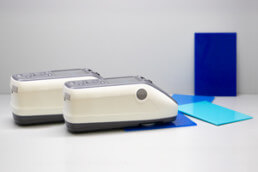Same Instrument Models, Different Color Measurement Results?
When coordinating the color of a product or a sample internally or throughout the supply chain, measurements of the object’s color are often performed by two or more instruments. Instruments that are not the same geometry or model may generate significantly different color values than each other, making it more difficult and time-consuming to communicate and meet product color specifications across locations. This is because of the different angles at which they illuminate an object to detect its color or other factors. While the optical system geometry of the instruments should be standardized, it is also recommended to use the same instrument model in each location (e.g., two Konica Minolta Sensing CM-3700A Plus Spectrophotometers).
When measuring the same color sample, two instruments of the same model should deliver measurement results (e.g., absolute L*a*b* or color difference values) closer to each other than two instruments of different models. The inter-instrument agreement value, defined in each instrument’s specifications, gives users an understanding of how close two or more instruments of the same model will read the same color. The smaller the inter-instrument agreement value, the closer the results will be. This is particularly beneficial when sharing measurement data to ensure the color of a sample is within specification.
When using the same instrument model as another department or facility, however, measurement results can still vary significantly. This is likely due to lack of instrument maintenance or standardization in measurement procedures and conditions between locations. Below are tips to eliminating or minimizing differences in measurement results between two or more instruments of the same model.
Instrument Maintenance for Measurement Accuracy
- Calibrate target plates and instruments at scheduled times to maintain measurement accuracy and optimum performance
- Remove dirt, grease, and other residue from instrument and calibration plates so as not to affect the accuracy of each measurement reading
Standardized Color Measurement Practices for Consistent Results
- Standardize a color space and color difference formula to ensure the instruments are using the same scale to quantify and calculate color
- Define standard illuminant(s) for the instruments to calculate the color of a sample as it would appear under each lighting condition
- Define the standard observer, either 10 degree or 2 degree, for the instruments to calculate the color of a sample with the same field of view
- Define procedures for the preparation and presentation of the sample for measurement, including angle and measurement location(s) (see Sample Preparation and Presentation Best Practices)
If one department, facility, or supplier does not follow the standardized maintenance or measurement procedures and conditions, inconsistencies and inaccuracies in color measurement results are likely to occur. The procedures and conditions established for measuring each sample should be documented and shared internally and throughout your supply chain. With an instrument at one location measuring consistently with instruments at other locations, color values and specifications can be communicated, shared, and coordinated seamlessly.
If measurement results are still inconsistent, the instruments being used may not be ideal for your specific application. It’s important to identify the instrument best suited for your application by pinpointing which attributes are important to the appearance of your sample and the specifications needed to properly evaluate it.
To find which solution best fits your application and operational needs, please browse through our line of high performance measurement instrumentation.
Bench-top Spectrophotometers >
High precision instruments ideal for measuring and evaluating the color and appearance of opaque, transparent, and translucent samples under various illuminants within laboratory environments
Portable Spectrophotometers >
High precision, handheld instruments ideal for measuring and evaluating the color and appearance of samples under various illuminants within production and manufacturing environments
Colorimeters >
High accuracy instruments ideal for measuring and comparing the color of samples under a daylight illuminant within quality control, quality assurance, and R&D fields
Like this article? Click here to sign up for our monthly Color Trends & Technology newsletter to stay updated on the element of color, best practices for controlling and evaluating the color of objects, educational seminars, and advanced technology for research and manufacturing environments.
The technological leader in color and light measurement solutions, Konica Minolta Sensing Americas helps organizations formulate, evaluate, and control color to meet product quality and operational goals more efficiently.










